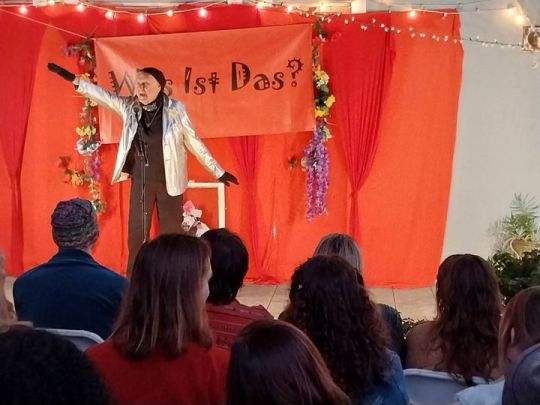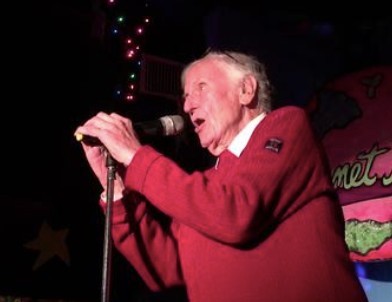#caffe cino
Text

Trobar Presents Poetry, Caffe Cino, New York, [1960(-1964)] [Between the Covers, Gloucester City, NJ]
#graphic design#typography#poetry#reading#broadside#trobar#robert kelly#george economou#armand schwerner#jerome rothenberg#david antin#frank kuenstler#caffe cino#1960s
39 notes
·
View notes
Text
Of Joe Cino and the Caffe Cino
Of Joe Cino and the Caffe Cino
Returning to work at Theater for the New City for a couple of months earlier this year gave me a shot in the arm in more ways than one. We’ve been living in a sort of frustrating exile since early 2018; it was nice to be back in the city on a regular basis, to bump into lots of old friends, and revisit old haunts. One day, while killing time before an evening performance, I stumbled across a…

View On WordPress
#avant-garde#Caffe Cino#experimental#gay#Greenwich Village#history#Indie Theatre#Joe Cino#off-off Broadway#theater#theatre
2 notes
·
View notes
Text
Sad passing of a gay theatre pioneer. Wish I had an opportunity to meet him.
NYTimes: “(The Haunted Host) was so much before its time,” Mr. Fierstein said in a phone interview. “Here you have a play where the strange person, the bizarre person, the person who was the antagonist, was the heterosexual. The normal person, the one with real emotion and real love, was the gay character. We forget our history, and now we have people who want to erase our history. This is why Robert’s work is so important.”
(Times) For a while, Mr. Patrick was known, perhaps a bit hyperbolically, as the world’s most produced playwright, with his work performed at small theaters in Minneapolis, Toronto, Vienna, Brazil and New Zealand, often all at the same time. In 1978, The Minneapolis Star Tribune reported, “Certain works, such as ‘Kennedy’s Children’ and ‘Camera Obscura,’ are quite probably being done somewhere every day of the year.”
In 2014, Henrik Eger of The Seattle Gay News asked Mr. Patrick if there was anything he hadn’t yet done but wished he had.
“True love,” he said. “And I would like to have the money to build or buy a theater in L.A. with enough ground space that I could call it Robert Patrick’s Free Parking Theater, because in L.A. the theater would fill up for every performance no matter what show was on, just because of the magic words ‘Free Parking.’ Then I could do whatever plays I liked.”
1 note
·
View note
Text
R.I.P., R.P.
In the late '70s, when I was in high school, I saw a production of Kennedy's Children at the Penn State/Behrend theatre. After the show the playwright, a hippie longhair type in bib overalls named Robert Patrick...

...gave a Q&A about life in New York's Off-Off-Broadway Theatre scene, of which he was a co-founder; he wrote prolifically for Caffe Cino and LaMama and other celebrated venues of the period. Kennedy's Children was his most famous play, premiering in London before opening on Broadway in 1975, where it won a Tony for star Shirley Knight.
I was already something of a theatre geek, but Patrick's talk made a big impression on me about the possibilities for doing theatre outside the mainstream, even though I didn't have the nerve to ask him a single question. A few years later, in the '80s, I was assistant director of another production of Kennedy's Children, and also appeared in it.
Decades after that, in mid-2021, I connected with Robert over Facebook. He was in his '80s and lived in L.A., in poverty, I think, but also in seemingly immense good cheer, still socializing, still walking and photographing his neighborhood, still performing with underground groups...



...and most certainly still writing. He seemed to devote himself mostly to pouring out poetry--witty, urbane, sophisticated, classically learned, allusive, ruefully romantic, gloriously rhymed poetry, posting large amounts of it almost every day. Sometimes he would post five or six poems at once, under the heading "Who Left the Poet On?"
The best of this stuff was, to me, stirringly beautiful, but as far as I know he never submitted it for publication, though I doubt I was the only person who urged him to. He was probably right that his style was too out of fashion for most bigtime rags these days, but I hoped that maybe his illustrious status as both a New York icon and a gay icon might persuade some of the big mags to make an exception and publish some poetry that was actually, you know, good.
In any case, I regularly commented and messaged Robert in the most effusive manner--quite sincerely, mind you; he may have been my favorite living American poet. And then, alas, Sunday I was jolted to learn that he was no longer a living American poet. He had a date for coffee with a friend, and when he didn't show the friend had the police do a welfare check on his apartment. They found that he had died in his sleep, at 85.
I'm more rattled by this passing than I would have expected. I realized that I had, for the last couple of years, nursed the daydream that I would stage Kennedy's Children or one of his other plays here in the Valley somewhere, and bring him out here to soak up some well-earned adulation. Like so many projects I think of, I wish I'd jumped on it a little sooner.
I can't claim that I really knew him, of course, but I spent a long time last night going through the many lengthy online chats I was lucky enough to have with him, discussing everything from the poetry of Catullus to the Oscars. I sent him a few of my own poems, about which he invariably gushed and even kindly posted a couple of them on his own page.
The Thursday before Easter I sent him a poem of mine called "A Prayer for Maundy Thursday," and on April 12 he wrote back to say that he read it ten times and found it "...more frightening with each reading. What a brave poem." I'm choosing to take that as praise; in any case the idea that Robert Patrick saw fit to read anything by me once, let alone ten times, is quite an If My 18 Year Old Self Could See Me Now sort of moment.
He then asked me if I had ever heard the story that Dante's neighbors called him "the man who's been to Hell." I replied that I hadn't heard that, and he asked "Do you think Milton's neighbors whispered about his trip to Eden?" This was his last message to me; I messaged that maybe Milton's neighbors thought that's why he was blind, but he never replied.
R.I.P., and peace and joy eternal on your own travels sir. Thank you for the encouragement, the example and all that abundant, exquisite verse.
#robert patrick playwright#kennedy's children#shirley knight#catullus#dante#john milton#off-off-broadway#caffe cino
0 notes
Text

Peter Moore Diane Di Prima at Caffe Cino, Greenwich Village, New York City 1968
My friend wears my scarf at his waist
I give him moonstones
He gives me shell & seaweeds
He comes from a distant city & I meet him
We will plant eggplants & celery together
He weaves me cloth Many have brought the gifts I use for his pleasure silk, & green hills & heron the color of dawn
My friend walks soft as a weaving on the wind
He backlights my dreams
He has built altars beside my bed
I awake in the smell of his hair & cannot remember
his name, or my own.
-- Diane Di Prima, "An Exercise in Love"
33 notes
·
View notes
Text
3 notes
·
View notes
Text
I want an interview where Bernadette can talk about doing Dames at Sea at Caffe Cino AND I want the interview that Donna DeSeta did with the guy who wrote the Cino book
4 notes
·
View notes
Photo

THE FRIDAY PIC shows the actors Ondine (as Scrooge) and Charles Stanley (as Señor Oro) in a scene from last night’s first-ever (legible) projection of Andy Warhol’s “Xmas Carol," which was his (sort-of) record of the play “Chas. Dickens’ Christmas Carol,” by the underground poet (and sometimes scoundrel) Søren Agenoux. The show played for a month at New York’s Caffe Cino during the holiday season in 1966, and Warhol caught it on film at some point late in its run. Yesterday’s screening was part of the launch party for the new book “I Insist on Being: Selected Writings of Søren Agenoux,” in which editors Gerard Forde and Michael Smith at last shed light on one of the more obscure but fascinating figures of the New York underground, and of the Factory scene around Warhol.
I was surprised to see how a non-Factory production like Agenoux’s riff on Dickens still seemed to orbit around Warhol, as though his gravitational pull was too great to resist: The silver foil used as a backdrop to this scene in the play is an obvious reference to the foil covering Warhol’s 47th Street studio. (It must have reminded him of his own first use of silver foil, in the sets he designed for Michael Kahn’s 1959 student production of Jean Cocteau’s “Orphée.”)
I was also struck by how much Warhol turned his “record” of Agenoux’s play into his own work of art. His in-camera edits seem to have cut out something like half of the play’s action, injecting full-blown modernist disjunction into a work that was only half-coherent to begin with.
Warhol’s Pop pictures get a lot of their force from an almost excessive legibility, which is also true of many of his greatest early films, like “Kiss” or “Empire” or “Blow Job.” So it’s interesting to see him taking “Xmas Carol” in an almost Cubist direction, and with all the virtuoso control of a Picasso. It’s easy to think of Warhol as the most casual of craftsmen — as an anti-crafstman, even — but there’s nothing casual about how brilliantly he shoots and frames and reconfigures Agenoux’s play.

6 notes
·
View notes
Text
Holiday treats at Caffe Cino | Lifestyle
Holiday treats at Caffe Cino | Lifestyle
The PDN Lifestyle team samples Cafe Sino holiday treats.
Elisa Cuevas, Gilana Santos, Samantha Barnett and Eliana Cuevas/PDN
To get into the seasonal spirit, PDN’s Lifestyle team went to the Hilton’s Cafe Sino to sample the holiday treats.
Seasonal treats included Strawberry Shortcake Yule Log, White Chocolate Green Tea Yule Log, Chocolate Hazelnut Crunch Yule Log and Chocolate Peppermint Dome.…

View On WordPress
0 notes
Text
Village news the zookeepers wife


And for the first time, I met a whole lot of like-minded people. And I wrote a play on Thursday and ran over there with it and the play opened on Monday. They were doing new plays on the following Monday. I heard on a Thursday that Theatre Genesis was putting on-doing new works cold. The Village at that time was absolutely wonderful. I felt that I could fit into the Caffe Cino. There was suddenly a place for me in New York. Long Island’s leading newspaper came in to do the story on our show and an eleven-year-old playwright, and that was that. I wrote my first play when I was eleven and it was done in the garage across the street here where we are in East Atlantic Beach. In his oral history with Village Preservation, Guare describes spending much of his childhood alone, as was his preference, reading, listening to soap operas, and going to the movies. John Guare was born in Manhattan on Februand raised in Jackson Heights, Queens, as well as upstate New York and East Atlantic Beach, where his father built the family a house in 1930. Each includes the experiences and insights of leaders or long-time participants in the arts, culture, preservation, business, or civic life. (The house originally stood at 112 Ocean Ave.Village Preservation shares our oral history collection with the public, highlighting some of the people and stories that make Greenwich Village, the East Village, and NoHo such unique and vibrant neighborhoods. It had been previously owned by four other families since the murders, one of which had the address changed to 108 Ocean Ave.
The Amityville House officially sold in February 2017 to an undisclosed owner for $605,000, which was $200,000 less than the original asking price.
The Amityville House still stands - with a new address He has since changed his story multiple times.
Murderer Ron, who's still alive and serving six 25-year-life sentences at a New York correctional facility, claimed he heard voices urging him to kill his family.
Son Daniel, who lives a quiet life in Queens, New York as a stonemason, claims the house ruined his life and that he continues to have nightmares to this day.
The Lutz's former lawyer William Weber - who fell out with them over money issues - came out in 1979, claiming the three of them came up with the horror story "over many bottles of wine.".
The couple was bogged down in legal and financial issues, which prompted skeptics to believe they had the motive to create a fantastical story to sell to the public.
After telling their story, George and Kathy took a lie detector test to prove their innocence.
Many question the validity of the Lutz's story
Other paranormal activity: A nearby garage door opening and closing an invisible spirit knocking a knife down in the kitchen a pig-like creature with red eyes staring down at George and his son Daniel from a window George waking up to wife Kathy levitating off their bed sons Daniel and Christopher also levitating together in their beds.
When a priest came to bless the house, he allegedly heard a voice scream "Get out!" He told the Lutzes to never sleep in that particular room in the house.
The Lutz family claimed to smell strange odors, see green slime oozing out of the walls and keyholes and experience cold spots in certain areas of the house.
George was said to wake up at 3:15 am every morning, which was around the time Ron carried out his murders.
Stepfather George Lutz had a history of dabbling in the occult.
Check out some of the scary facts claimed by the Lutz family, as well as other interesting ones about the infamous house whose horror has yet to die: The Lutz family experienced supernormal activity

0 notes
Text

Caffe Cino, watercolor 2022
Caffe Cino was the very first Off-Off Broadway theatre. Founded in 1958 by Joe Cino, the coffee-shop-turned-stagespace was also the birthplace of queer theatre in America.
I dedicate this painting to Joe, his lover Jon Torrey, and queer theatre.
#queer art#transmasc#theatre#queer theatre#theatre kid#watercolor#art#queer artist#trans artist#queer history#history#theatre history#caffe cino
6 notes
·
View notes
Text
y'all, please read about Caffe Cino
https://en.wikipedia.org/wiki/Joe_Cino?wprov=sfla1
3 notes
·
View notes
Photo

Bernadette Peters rehearsing Dames at Sea at Caffe Cino in 1966.
#Bernadette Peters#dames at sea#caffe cino#baby bernadette#broadway baby#broadway legend#musical theatre#off off broadway
18 notes
·
View notes
